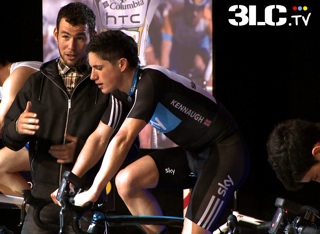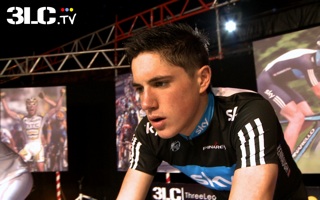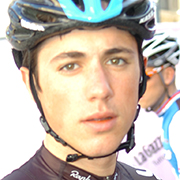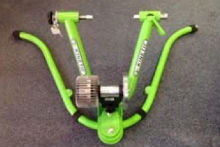It’s still “that time of year”.
Cold, and getting colder, the prospect of an evening or early morning training ride is not a pleasant one. With climatic conditions conspiring to keep us indoors for a few months longer, it’s time to reappraise the opportunities offered by the humble turbo trainer. But how best to use a static trainer? What common errors can be avoided? And how to overcome the demotivating effects of cycling on the spot?

The man with the answers to all these questions and more is Peter Kennaugh Snr, a principle character in the extraordinary success story that is Manx cycling. That an island with a population of less than 85,000 should produce the world road race champion, a member of the elite World Tour peloton, and a bright prospect among a potential-packed squad at one of Britain’s most successful UCI Continental teams is testament to the knowledge of the Isle of Man’s cycling community.
Just over a year ago, Kennaugh called upon the time of his sons, Team Sky’s Peter, and Rapha Condor Sharp’s Tim, and a certain Mark Cavendish, as well as other key figures on the Manx cycling scene, to make a series of turbo training DVDs that wold not only banish the boredom of static training, but by focusing on cadence and effort, dispense of the need for expensive power and heart rate monitors and the disappointment that failure to meet their fixed targets often brings.
The success brought by the DVDs – available to win in this week’s Friday Forum giveaway – was, admits Kennaugh snr, “half expected”.
“We tried to do something as different and it seems to have worked really well. We had a big bonus with all the professional riders who are involved. We asked Mark Cavendish and Peter Kennaugh and Tim Kennaugh and Mark Christian. The only time they were all home on the Isle of Man was between Christmas and New Year, this was 2010/11, and they all turned up – it was amazing. They all made it to this minute studio in the middle of the island. We were filming with about 20 cameras. The buzz was amazing,” he said.
For those new to turbo training, often the first challenge is choosing a model. With different types of trainer using different methods to generate resistance (fluid baths, magnets, and fans among them) it can be hard to know which to choose. Kennaugh’s view is that any type will do the job. The turbos used in 3LC’s videos are Elite fluid trainers, the same supplied to Team Sky. For Kennaugh, the more important consideration is the method used by the rider to gauge output, and for 3LC that means measuring cadence rather than power.
“There’s nothing worse than coming home from a long day at work, jumping on a turbo, a finding you have to do 280 watts for 20 minutes. You don’t get anywhere near it. With cadence, you just drop it down a couple of gears and get through the session. Half-way through the session, when your body’s warmed up, you find you’re able to push a bit harder. Rather than climbing off and not getting a session done, a guy with a nine-to-five job can still get in a couple of sessions a week,” he said.
Another debate surrounding the use of static trainers lies in the extent to which they should be used.

Are they a tool solely for winter, a device to be used in emergency when cycling outdoors presents the risk of drowning or pneumonia? Or should they be an ever-present part of your training programme, as championed by no lesser authority than Graeme Obree in his training manual, The Obree Way, as the only reliable means of recording your training effort and subsequent rate of improvement? “The turbo can be part of your year-round training programme,” Kennaugh agrees.
“When the sun’s shining, you want to get out on the road, but you can have problems getting in a properly structured session. You can’t get a decent work out if you live in a suburb or town and you’re stopping for traffic lights. For 45 minutes on the turbo, you can probably do the equivalent of what you could manage in two hours on the road. That’s where the turbo will come in for people with a limited amount of time.
“This year, the weather hasn’t been good. A couple of mid-week sessions on the turbo, maybe Tuesday or Thursday, can be mixed with getting out on the club runs at the weekend, and then the ‘club 10’ later in the season. Turbo training isn’t everybody’s cup of tea, and that’s why we tried to make the videos as interesting as possible. You have got to get endurance rides in at this time of year, but a lot of guys we know who have jobs and mix turbo sessions with endurance rides are very competitive.”
So with the knowledge of what to use (any design in conjunction with cadence as the principle measure of rider output) how to use it (year-round if desired as part of a mixed programme with on-the-road endurance rides), what common pitfalls are there to avoid? For Kennaugh, the newcomer’s temptation to train too hard is one to resist if the outcome of blowing up and failing to finish the session is to be avoided.
“People tend to start a session and absolutely blast it, then get three-quarters of the way through and they have to climb off. With our cadence idea, we advise to go through the first sessions easier than you might have intended and to use lower gears. Aim to get through the session and pitch yourself. If you’re struggling, there’s no shame in changing down. By using cadence, you still get through the session. With time, you become able to use higher gears, and that’s how you see improvement,” he says.



